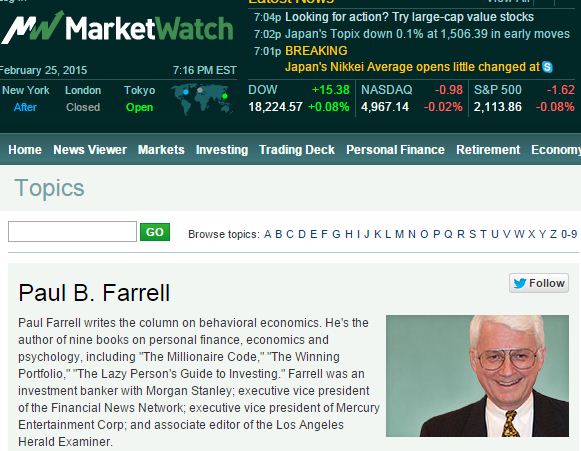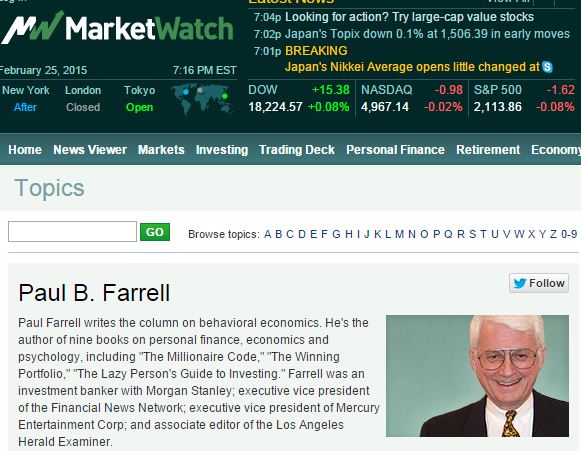 이미지 확대보기
이미지 확대보기폴 파렐은 한국시간 26일 새벽 공개한 글에서 “요즈음 미국 증시의 분위기와 여건이 대공황의 서막이 된 1929년, 닷컴 버블이 터진 2000년, 그리고 글로벌 금융위기가 시작된 2007년과 흡사하다”고 지적하면서 “내년에는 뉴욕증시의 다우지수 기준으로 주가가 절반 선으로 떨어질 수 있다”고 말했다.
1929년과 2000년 그리고 2007년 3차례에 걸친 증시붕괴 직전에는 예외 없이 주가가 연일 최고 기록을 경신하고 있었는데 최근의 주가지수 최고치 경신도 그 양태가 비슷하다는 것이다. 또 성장률이 빠른 속도로 치솟고 있는 것도 당시의 모습과 유사하다고 폴 파렐은 지적했다.
폴 파렐은 글의 서두에서 “지금은 2016 주가 대붕괴의 카운트다운을 시작할 시점이다”라면서 “단순한 미세조정이 아니라 50%는 떨어질 것을 염두에 두라”고 말했다.
폴 파렐의 ‘2016년 증시 대붕괴론’의 원문은 다음과 같다.
It’s time to start the countdown to the crash of 2016. No, this is not a prediction of a minor correction. Plan on a 50% crash.
Most investors don’t want to hear the countdown, will tune out. Basic psychology. They’ll keep charging ahead with a bullish battle cry, about how the Nasdaq will keep climbing relentlessly to a new record above 5,048... smiling as they remember reading that a whopping 73 companies are now in the Wall Street Journal’s Billion Dollar Start-up Club, with Uber ($41 billion), SpaceX ($12 billion) and Snapchat ($10 billion).
Hearts race even faster reading in Bloomberg BusinessWeek that “China’s IPO Boom Mints Billionaires” and Jack Ma’s Alibaba fortune is now valued at $35.1 billion.
Yes, technology IPOs are in the lead, and with all that good news, it’s easy to understand why investors tune out, don’t want to hear the warnings, no countdown to the 2016 crash.
But the crash of 2016 really is coming. Dead ahead.
Maybe not till we get a bit closer to the presidential election cycle of 2016. But a crash is a sure bet, it’s guaranteed certain: Complete with echoes of the 2008 crash, which impacted on the GOP election results, triggering a $10 trillion loss of market cap ... like the 1999 dot-com collapse, it’s post-millennium loss of $8 trillion market cap, plus a 30-month recession ... moreover a lot like the 1929 crash and the long depression that followed.
Plus cycles theorists warn that we dodged a crash in 2012-2013, thanks to the Fed’s stimulus and cheap-money polities. Or rather delayed it, which adds more power to the next one.
Why not sooner, you ask? Why not in 2015? Yes, Mark Hulbert’s already warned that the “stock market risk is higher today than it was in the dot-com era.” Yes, a dip is possible. MarketWatch’s Sue Chang writes of a 10%-20% stock-market correction by July.
But we also know markets are typically up the third year of a presidency. So if no crash is in the cards this year, then why bother with warnings and a countdown? Why bother building up the 2016 elections with lots of dark early warning signs, and doom-and-gloom warnings for the next 18 months?
Why? Simple, behavioral economists have long been telling us that investors will either choose to stay in denial till it’s too late, never having learned the lessons of history when the market collapsed in 2008, 2000 or 1929, when they collectively lost trillions. Or we know some investors really do want to heed the warnings, so they can plan ahead, avoid big losses, and take advantage of opportunities later, at the bottom.
Deja vu 2007: Watch another presidential hopeful collapse!
Let’s compare 2016 with earlier crashes: 2007 to 2000 to 1929, knowing all bulls drop into bears eventually. Basic cycles theory. And this next one will trigger losses bigger than 2000 and 2008. So bet against the house at your peril.
Jeremy Grantham’s already on record predicting that “around the presidential election or soon after, the market bubble will burst, as bubbles always do, and will revert to its trend value, around half of its peak or worse.”
Paul Farrell writes the column on behavioral economics. He's the author of nine books on personal finance, economics and psychology, including "The Millionaire Code," "The Winning Portfolio," "The Lazy Person's Guide to Investing." Farrell was an investment banker with Morgan Stanley; executive vice president of the Financial News Network; executive vice president of Mercury Entertainment Corp; and associate editor of the Los Angeles Herald Examiner.
/글로벌이코노믹 김재희 기자





























![[초점] 아마존, 창고 로봇 100만 대 넘어…사람과 '동료'에서 '경...](https://nimage.g-enews.com/phpwas/restmb_setimgmake.php?w=80&h=60&m=1&simg=2025070119212508076fbbec65dfb1161228193.jpg)












